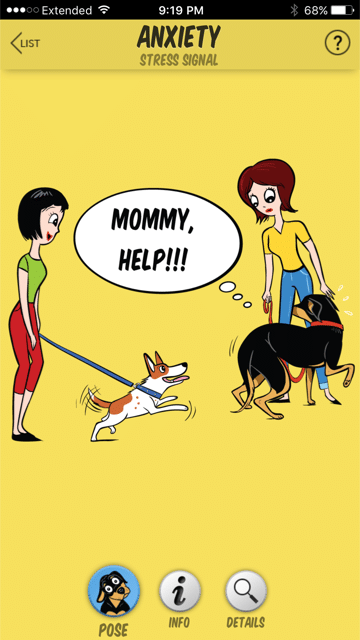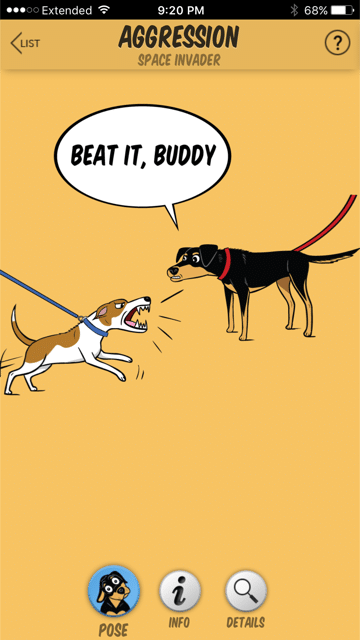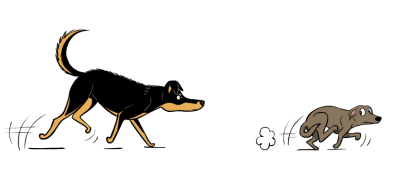The post What Do Raised Hackles — or a Dog’s Hair Standing Up — Mean? by Jill Breitner appeared first on Dogster. Copying over entire articles infringes on copyright laws. You may not be aware of it, but all of these articles were assigned, contracted and paid for, so they aren’t considered public domain. However, we appreciate that you like the article and would love it if you continued sharing just the first paragraph of an article, then linking out to the rest of the piece on Dogster.com.
Raised hackles, the hair on a dog’s back and neck, confuse many pet parents. They may see them as a sign of aggression, but that isn’t always the case. Raised hackles do not qualify as a behavior, as they are an involuntary reflex triggered by something that put the dog into a state of arousal. There is actually a medical term for the reaction: piloerection (pilo referring to “hair” in medical terms).
Raised hackles could be a sign of fear, anxiety, excitement, nervousness or anger. If you notice raised hackles on your dog, you must look at other body language and the context to understand what is happening. Only then can you know how to respond.
Raised hackles as anxiety
What do raised hackles indicate? Photography ©alexkich | Getty Images.
My German Shepherd Dog, Ginger, used to display raised hackles every time she met a new dog. I rescued her when she was 7 months old. She hadn’t been properly socialized because she had parvovirus as a pup and needed to be kept away from other dogs until she fully recovered. When she was well enough to finally meet other pups, she was beyond the critical period of puppy socialization and was out of control on the leash, which is why I rescued her.
Meeting new dogs caused her much anxiety, and as an adult that manifested into raised hackles. All of her other body parts conveyed appeasing signals: low horizontal tail wagging, squinty eyes and a paw lift — all with wiggly interest. The good news was that I understood her behavior, and the better news was that dogs we met also read and understood her body language, that she was anxious yet friendly, willing to greet. This image from my Dog Decoder app perfectly represents Ginger in this state.

Anxiety can make a dog’s hackles go up, as seen on the little dog here. (Image from Dog Decoder smartphone app/illustration by Lili Chin)
Ginger got over her initial anxiety within the first 60 seconds of meeting a new dog, and she was the friendliest pup who loved to rough and tumble with the best of them. If I didn’t understand her raised hackles and body language, and saw it as aggression that required her to be removed from the situation, her continued lack of socialization would have caused her to become more anxious and even aggressive, when that wasn’t her original intent.
Raised hackles as excitement
Jack, another pup I worked with in the past, also displayed raised hackles whenever he saw another dog, but because of a different trigger. His was pure and uncontrollable excitement, always wanting to play. He was overly exuberant in his greetings, and oftentimes this put other dogs off from wanting to meet him.
Many dogs displaying this kind of behavior have raised hackles while the rest of their body suggests play: fast horizontal tail wagging, forward ears, even barking and lunging on the leash in excitement. Some might see this as aggressive, too, because of the raised hackles, but for Jack in this situation, it wasn’t at all.
Raised hackles as aggression
In this next image, you’ll see slightly raised hackles at the shoulders and just along the top of the left dog’s back, along with ears back and down, hard eyes, tail high, wide open mouth with teeth showing, and more of a rigid body posture. This combination of raised hackles and body behavior signals aggression from the dog.

The whole picture here shows aggression, not just the raised hackles. (Image from Dog Decoder smartphone app/illustration by Lili Chin)
Raised hackles as predatory
If a dog is highly aroused, the hair can stand up from their neck all the way to the tip of their tail, as shown in the predatory stalking image below. However, there is no consistent pattern that correlates the amount of hair raised and where to a particular behavior. Each dog and each situation are different.

The hackles are up on the stalking dog. (Image from Dog Decoder smartphone app/illustration by Lili Chin)
The bottom line on raised hackles
It’s so important to read your dog’s entire body language and to take context into consideration if raised hackles present. If you don’t, you could create a problem where there wasn’t one before. You could turn a fearful or shy dog into an aggressive one because of how you respond.
The best way to handle a dog with raised hackles is to redirect his attention until you can better understand the triggers and see a pattern. If the reaction persists and escalates, consult a behaviorist who can help you help your dog feel less of whatever triggers them.
Understanding your dog’s body language is crucial to helping our dogs live an emotionally happy and healthy life.
Thumbnail: Photography ©anactor | iStock / Getty Images Plus.
This piece was originally published in 2017.
About the author:
Jill Breitner is a professional dog trainer and dog body language expert. She is a certified Fear Free Professional, Fear Free Professional for Foundation for Puppies and Kittens, as well as Certified in Animal Behavior and Welfare. She is the author of the Dog Decoder, a smartphone app about dog body language. Join Jill on her on her Facebook page.
Read more about dog training on Dogster.com:
- 7 Ways to Turn Walking the Dog Into a Workout
- Dog Zoomies: Why They Happen and What to Do
- Why Do Female Dogs Hump? Reasons for Female Dog Humping
The post What Do Raised Hackles — or a Dog’s Hair Standing Up — Mean? by Jill Breitner appeared first on Dogster. Copying over entire articles infringes on copyright laws. You may not be aware of it, but all of these articles were assigned, contracted and paid for, so they aren’t considered public domain. However, we appreciate that you like the article and would love it if you continued sharing just the first paragraph of an article, then linking out to the rest of the piece on Dogster.com.
No comments:
Post a Comment